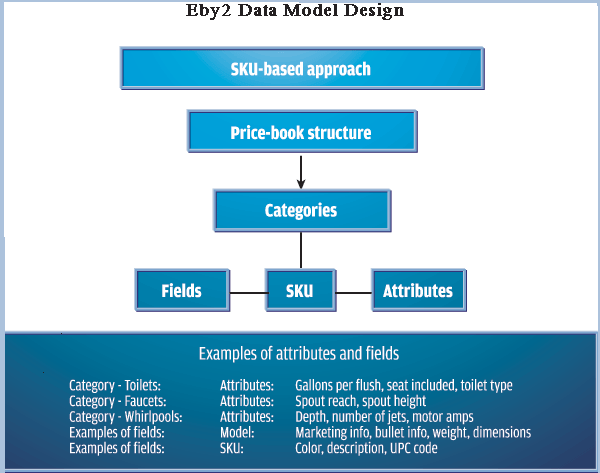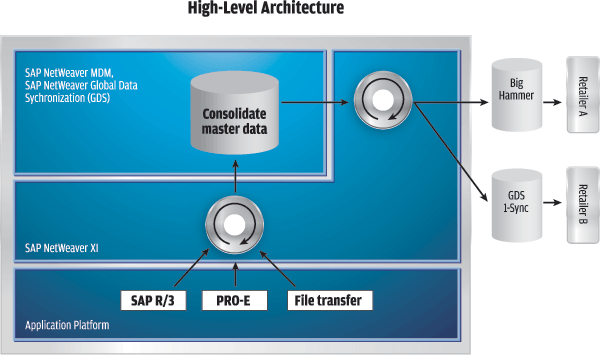American Standard needed to provide timely data feeds to one of its biggest customers. It also had a product catalog that seemed to be consistently out-of-date. SAP NetWeaver Master Data Management filled both of these needs. Learn the lessons
how American Standard Delivers the Data with MDM
Client: Client: American Standard
Headquarters: Piscataway, New Jersey
Parent company: American Standard Companies Inc.
Products: American Standard brand in the Americas and
Asia-Pacific
Ideal Standard brand in Europe
SAP
landscape:
SAP NetWeaver BI
SAP NetWeaver MDM
SAP NetWeaver Portal
SAP NetWeaver XI
SAP R/3
For mass-market manufacturers today, the traditional goals of selling the right product to the right audience at the right price through the right channel are only part of a winning market strategy. Delivering the right information about those products, at the right time, in the right format has become essential to satisfy both business partners and consumers. Furthermore, to meet its own internal business goals, the manufacturer must publish all this information at an acceptable cost in cash, time, and resources.
American Standard is one of the global manufacturers attempting to meet those challenges with master data management (MDM). A leading provider of bath and kitchen equipment sold in the Americas, Asia, and Europe under the American Standard and Ideal Standard brands, the company is part of American Standard Companies Inc., an $11.2 billion Inc. that also makes and markets air-conditioning and vehicle-control systems.
The immediate incentive for the MDM implementation came from a do-it-yourself retailer that has been a key American Standard channel partner. The retailer needed timely data feeds for its stores, sales kiosks, and Web site, and particularly for its special-order program.
Collecting and managing all that data from the suppliers was the job of a third-party product-data service called Big Hammer. The service collects and maintains — among other things — marketing data, logistics data, product images, and product attributes for all merchandise that the retailer carries. Suppliers have the option to enter product data either through a Web application provided by Big Hammer or transmit data as an XML feed. The data transmission through XML is more efficient and dependable and is the method of choice for suppliers with a large number of products. Suppliers must be ready to promptly acknowledge and record receipt of electronic documents, and to deal promptly with transmission issues.
It was the very breadth of American Standard’s product offering and the scope of its manufacturing and sales operations that created the challenge for meeting Big Hammer’s requirements. The company’s products include sinks, toilets, faucets and other fixtures, and some furniture, as well as integrated bath suites. In other words, there are thousands of stock-keeping units (SKUs) to document, and thus mountains of master data to cleanse and validate.
“The special-order program is a revenue-increasing opportunity for American Standard because it generates bigger-ticket sales that involve combinations of products. We needed a robust process that would enable automated transmission of accurate information using industry standards,” explains Gelyn Almanzar, American Standard’s manager of customer-facing applications. “Our previous process for gathering and sending our data to the retailer required multiple resources and did not provide data validation. Therefore, we were at high risk of either not meeting our customer’s demand or sending invalid information to be published.”
Clearly, neither alternative would be acceptable. But, could an MDM solution really enable American Standard to meet the needs of its allies and unlock new business opportunities?

Setting Goals and Building the Model
Beyond the Big Hammer situation, compelling as it was, American Standard had
broader objectives in implementing MDM that would need to be incorporated into
the data model and system landscape of its solution.
“Our master data — related to products, customers, and vendors —
drives a wide range of critical business processes including ERP,
product-catalog publication, EDI [Electronic Data Interchange], BI [business
intelligence], and Web sites,” says Mukunda Krishnaswamy, manager of
enterprise data strategy and reporting. “We needed a comprehensive solution
to create, manage, and integrate our master data across an enterprise that
spans multiple systems, including [SAP] R/3.”
The master data solution would have to deliver business value in the
following ways:
- Improve accuracy and consistency of master data through centralized master
data maintenance and workflow
- Drive efficient exchange of information with retailer customers
- Centralize and optimize print and Web publications
- Enable future ERP initiatives that would make use of service-oriented
architecture (SOA)
The MDM project team developed a data model they believed would meet these
goals (see “MDM Data Model Design”). The model was constructed around the
most basic data component: the SKU. According to Krishnaswamy, this was one of
the most important decisions the team would make. “When you build your data
model, you have to look at the data outside the IT perspective,” he says.
“You have to wear a business hat to get a sense of how your customers are
using the information and how it’s being published, whether on a Web site or
in price-book catalogs. Once you have a good sense of how the information is
used, that will enable you to build the right data model.
“One of the lessons for us was to stick with a standard data model as much as possible and find ways to customize it to meet our business requirements. What’s in the box for the product repository, the MDM standard product model, is at the SKU level. That was one of the key considerations for us because it gives us the ability to use the standard extraction protocols to integrate MDM with the R/3 system.”
American Standard was already an extensive user of SAP technology, and it selected several components of SAP NetWeaver Master Data Management (SAP NetWeaver MDM) for the new landscape. These included MDM Import Manager, MDM Data Manager, MDM Console, and MDM Syndicator (see “SAP NetWeaver MDM Components Used for Phase I” below).
The system landscape for SAP NetWeaver MDM has three tiers: development,
quality assurance, and production and runs on Microsoft Windows Server, with
Oracle 10 as the backbone.

One of the things we had in mind was that eventually American Standard needed the tools to centralize integration, especially from an SAP point of view,” she recalls. “We decided to use [SAP NetWeaver] XI with the intention of it helping us with our data transformation on the syndication side, and eventually helping us to centralize our interfaces.”
Partnering for Implementation
The IT team went to training in August 2006, officially kicked off the retailer’s phase of the project in September, and went live in mid-December (see “Implementation Game Plan” below). Along the way, there was a sense of urgency because, according Jesus Santacruz, data specialist, “execution and rapid implementation were key to demonstrating progress to management.”
Implementation Game Plan
American Standard has completed the first of two phases of SAP NetWeaver MDM implementation. Phase I was made up of work needed to participate fully in the retailer’s special-order program. Work began in mid-September 2006 and concluded in mid-December.
The following tasks were completed by a team of six members, in this order:
Design data model
Import data mapping to support data loading
Write syndication scenarios to send data (FTP, email, XML)
Validate master data and cleanse import routines (business side completes 97% of this task)
Import all data prepared by the business side into SAP NetWeaver MDM
Validate SAP NetWeaver MDM data and sign off (December 4, 2006)
Go-live (December 15, 2006)
In Phase II, American Standard’s goal is to publish its all-important “price book” for customers with the most timely and accurate information and the least possible time and cost. Steps in this phase include:
Centralize all product data (loading active and historic master data)
Standardize product-master workflow (change management and data validation)
At the same time, the team wanted to be thoroughly prepared. “We spent two weeks just on data-modeling, without touching [SAP NetWeaver] MDM,” says Santacruz. “As soon as we finished data-modeling analysis, we went to implementation. And that meant only three days for building the prototype.”
Project managers acknowledge that the rapid and smooth implementation resulted in large part from American Standard’s choice of SITA Corp. as an implementation partner. An SAP Service Partner based in New Jersey, SITA provides consulting, solutions, and managed services to clients in the United States and abroad.
“We had two other companies that we also interviewed,” says Almanzar. “I think that one of the key things that made us look more into SITA were the facts that it had already done [SAP NetWeaver] MDM, and that it was the only company that would send us the resources to be with us from day one until go-live. It was a one-to-one type of thing, and by the time they left, we felt secure and convinced that we were going to be able to run the show on our own. I don’t believe that companies that sent the project offshore or outside our office would have created that sort of comfort level.”
The value of the partnership was evident even in prototyping, says Santacruz. “We had issues with our [hardware] sizing, so that delayed the deployment of our boxes for the development, quality assurance, and production systems. To overcome this delay, we used a laptop computer loaded with MDM software to continue our data modeling and prototyping work. With SITA’s help, the in-house project team was able to develop a working product model and successfully deliver a proof-of-concept system to the management team. That was a lesson learned: Always have a Plan B.”
Phase I: Measuring Payoff and Managing Change
After the SAP NetWeaver MDM system was loaded with marketing, engineering, and sales data, the project team was able to measure its technical effectiveness by directly checking the quality of imported product data. Values that show up in SAP NetWeaver MDM attributes clearly indicate whether data coming from an information repository was valid, says Santacruz. “During our different phases, we knew whether the sourcing data had been cleaned or not and what progress we had at a specific time.”
American Standard’s participation in the retailer’s special-order program through Big Hammer in itself provides a continuing source of performance-benchmarking. So far, American Standard has seen the following business benefits from the SAP NetWeaver MDM implementation:
Product data can be handled within the company by fewer teams using fewer resources.
Data is demonstrably cleaner and is 100% validated. Marketing data is checked, including spelling, before it is shared with retailer customers.
Consolidation of data allows more time for analysis and requires less time for maintenance.
The ability to consolidate product, customer, and vendor data in one repository supporting multiple languages helps greatly in coordinating information globally and makes it easier to roll out the program to different locations.
Organizationally, IT is responsible for maintaining and validating the data. According to Almanzar, this was not a long-term strategic decision but a response to urgent customer demand. “Since it was a short project and our immediate goal was to be able to send product information to the retailer, we decided that training the user community on a new tool was going to require a bigger go-live window, something we did not have because our customer’s demand was for us to be ready by December 6, [2006].”
The IT team knows, however, that it must soon turn data ownership over to the end users, and to that end a governance team is designing best practices and workflows for such tasks as gathering data from desktops and spreadsheets. “A good analogy is that it’s like a team sport; you need to have a coach,” says Krishnaswamy. “You see the ball being passed back and forth between engineering and marketing and sales, and IT is involved all along the way. But the governance team is the one to orchestrate the whole thing.”
Phase II: Driving Data Syndication and Workflow
Beyond its key relationship with the retailer, American Standard intends to use SAP NetWeaver MDM as the engine to syndicate its product data to customers and to its internal and external Web sites. This is a strategically vital effort, because it involves the single most valuable tool in the company’s product-marketing toolbox: its price book.
Now published annually in printed form, the price book is a catalog that lists the features and prices of every bath-and-kitchen product that American Standard makes. Publication is a marathon back-end effort that spans the entire year, and involves vast numbers of personnel at all levels from sales and marketing to logistics, engineering, manufacturing, SAP, and so on through a complete publishing operation.
“If we need the business to sponsor us — and we do — then we need to show some sort of face value to the project,” explains Almanzar. “The way we do that is by saying, ‘we can do price-book publication through [SAP NetWeaver] MDM,’ and we know we can do it.” She says marketing management, which drives the price-book project, expects to see a reduction in the lead-time and resources needed to publish the price book. The eventual goal would be to publish it more frequently, perhaps even quarterly.
SAP NetWeaver MDM’s ability to centralize information previously scattered throughout the enterprise is the key to simplifying price-book publication, but it also fulfills another far-reaching objective: to centralize workflow. “That’s where our major challenge is,” says Krishnaswamy. “The engineering team has a tool that they use to maintain a set of attributes; R/3 has other attributes that are being maintained; and then there are attributes of workflow in [Microsoft] Excel. What we need is the ability to coordinate and keep all these [attributes] in sync. That’s one of the areas where I see [SAP NetWeaver] MDM adding a lot of value for us.”
Bottom Line: Adding Value
Whether all the American Standard Companies’ lines of business will roll out SAP NetWeaver MDM remains to be seen. For one thing, the Inc.’s bath-and-kitchen business may soon be operating under different ownership. In February, the corporate board of directors voted to sell that side of the business this year as part of an overall refocusing of its business units.
Even if the plan goes through, the work done by the SAP NetWeaver MDM implementation team will still bear fruit. After all, accurate, up-to-date, easily accessible product and price information, along with a proven method for publishing it to customers at all levels, can only raise a business’s value.
7 Lessons Learned
Line up strong sponsorship from leaders on both the business side and the IT side of the organization. SAP NetWeaver MDM requires IT expertise, but it’s not “just” an IT initiative. Marketing, sales, manufacturing, and distribution will all be affected, and you need to approach all these disciplines at the outset for advice and support. Sponsorship can also include business partners (such as the retailer mentioned here), whose relationship with your company is of critical business concern.
Take a realistically phased approach to the project, in particular one that allows ample time and resources for project-scoping. Don’t try to accomplish everything at once. Set a concrete short-term goal, such as optimizing data ex- change with a key business partner, that will yield visible, measurable business improvements. Set longer-range comprehensive goals, such as centralizing master data for syndication, that will leverage the skills learned in the initial project.
Wear a “business hat” when you’re building the data model and look carefully at the kinds of product information your organization uses. In the world of mass-market manufacturing, that means analyzing and mirroring the practices in your product catalog.
Choose a skilled implementation partner with solid experience in SAP NetWeaver MDM projects, and make use of that partner’s expertise to build your solution. As important as technical expertise are the ability and willingness to work with you onsite to test and troubleshoot your MDM solution.
Allow enough time for installation and sizing. SAP NetWeaver MDM can require more or different hardware resources than you might expect. In your first MDM implementation in particular, it’s difficult to predict precisely how the MDM solution will affect system performance. Also, budget time to prepare for the use of SAP NetWeaver XI, drawing on consultant and SAP advice.
Employ your best project-management skills to sell SAP NetWeaver MDM to management. Because MDM has long-term enterprise-wide benefits, you want to keep management enthusiastic and supportive over the different phases of the implementation. That means proving, in the initial project, that you can deploy MDM efficiently without draining staff or system resources, and without interrupting important business processes.
Set weekly goals and commit to meeting those deadlines. One of your first goals should be a thorough grounding in the concepts behind MDM. Instill a sense of urgency in your team to avoid getting distracted and delayed by the day-to-day issues of running IT and business departments. Use whatever mix of team skills will best enable you to meet the project deadlines. Let management see your progress in the form of reporting based on quantitative data.



